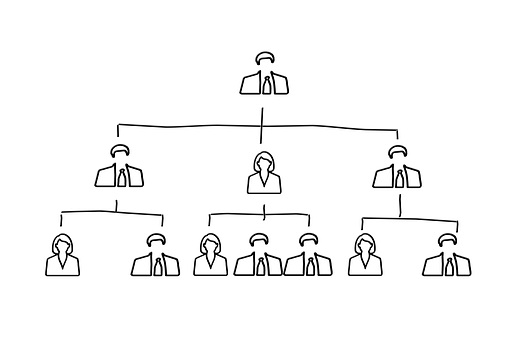We all know the story of Goldilocks and the 3 bears. As Goldilocks explored the bear’s home, she discovered that two-thirds of the furniture–and even the meals- were not a good fit. She was looking for what was “just right”.
Organization Charts can reveal a lot about whether or not the management is “just right” for the organization. They illustrate reporting relationships, scope of responsibility, authority levels, number of direct reports, etc. They are essential to understanding how the organization is structured. An org chart can easily reveal opportunities for cost reduction. Since they focus on management and supervisory levels this should be the first stop in analyzing labor cost reduction.
Organization Charts can be constructed in different ways and contain different amounts of details. Some just use job titles and slot them where they belong in the hierarchy. Others may identify each employee and have numerous “boxes” for the same job title.
Those that list each employee are generally used in Org Charts that are on the Departmental level. Org charts that represent the entire organization are generally based upon job title.
As CHRO, the org chart was an invaluable tool for uncovering opportunities for organizational improvement. There are many things that can be learned from the chart, but let me share two questions that frequently highlighted needed improvement.
Is the Org Chart too wide?
If your org chart is very wide and barely contained on legal-size (or bigger!) paper, what could this be telling you?
Well, we can see that the org has many divisions/departments and that there are probably many vice-presidents/directors or whatever the C-Suite title is used. This is common in organizations that use titles as status or reward. The business has a lot of VPs, Directors or Managers because everyone wants a title. Titles are related to status
In fact, if employees are complaining about “too many chiefs and not enough Indians”, you probably have title inflation.
What are the problems with this structure? Some things are easily obvious. When the chart is “too wide”, there are many silos. Each silo is led by separate managers with the same authority. This can result in competition, lack of cooperation, etc. It also can complicate many work process that may flow across departmental or “authority” lines.
Silos can lead to narrowed perception and focus. Communication becomes more complicated. Cooperation often depends upon the relationship of the silo managers.
What is the solution?
If the chart is too wide, then you should look for opportunities to combine or eliminate the silos. Start at the top and work down. Can this VP with only 1-2 direct reports handle more? Think creatively. We often had Clinical VPs also manage non-clinical support or administrative departments. Some directors that were previously “siloed” by function, may assume responsibility for several departments. This was true even if there functions weren’t related.
This worked well for those small departments that had fewer employees and the directors welcomed the increased experience. For example, rather than a Director of Security and Director of PBX, these positions were combined. Employee Health, Infection Control could be combined. Quality and Utilization Review didn’t need separate directors.
Is the Org Chart too tall?
An org chart that is too tall is one that usually cannot be contained on one page and is continued on one or more pages.
What should we look for when we suspect the organization suffers from “vertical rise” vertigo?
I would immediately suspect that the organization has too many layers! The vertical height of the chart is the result of many layers of management. The problem is not one of separate silos, but of many direct reporting relationships.
In this type of chart, I generally find a lot of management titles. Titles with “Assistant” are probably present and should be examined. VP, Assisatant VP, Director, Assistant Director, Manager, Assistant Manager, etc.
Problems with this are self evident. Multiple layers result in increased distance from the top to the front line of the organization. Redundancy, cross-checking, communication problems are all prevalent in organizations with excessive management layers.
Salary costs are probably higher than they should be.
At one hospital I worked at, we had a Director of Respiratory Therapy and an Assistant Director of Respiratory Therapy. All of the staff in the department reported to the Assistant Director. He did all of the hiring, management, performance appraisals for all of the employees of the department. The Director had only one direct report- the Assistant Director.
See how ridiculous this becomes? It was obvious that if the Assistant could manage the entire department, why did he have to report to a Director? That was some low hanging fruit.
What is the solution?
It should be obvious that management layers need to be eliminated! In every organization I was in, we eliminated all “Assistant” titles on all levels. You were either the VP-Director-Manager with full authority or you were not!
Take a hard look at the number of layers in your organization. Do you need so many? Is it title inflation?
To hatchet or not
Finding opportunities for improvement does not mean that you need to immediately eliminate positions or terminate incumbents. (Although staff are generally more tolerant and often welcome reductions in management positions more than when line positions are eliminated.)
In some cases we would eliminate a position but would do so without discharging the incumbent. We may have another position, or a transfer that would work. Some title changes such as eliminating “Coordinator” positions meant that the employee went back to the line work of the department. (This is probably what they were doing anyhow!)
My most used approach was to identify opportunities with the Senior Leader that I reported to. This was either the CEO or COO. We would generally agree on what opportunities existed.
Then we would wait for an opening to occur. A vacancy on the right level is an opportunity for either an elimination of the position, transfer, or combining of responsibilities. Attrition can be a wonderful thing. It is an opportunity to achieve a painless reduction or change in responsibilities.
Become the master of your org chart. Begin by asking these two simple questions that can lead you into a better understanding of your organizational structure. Like Goldilocks, you may discover what is too big, too small and what is just right!






